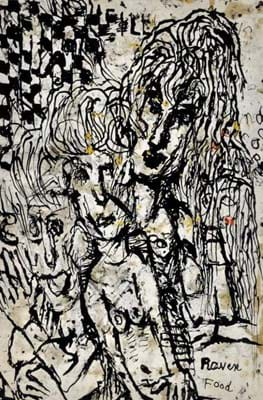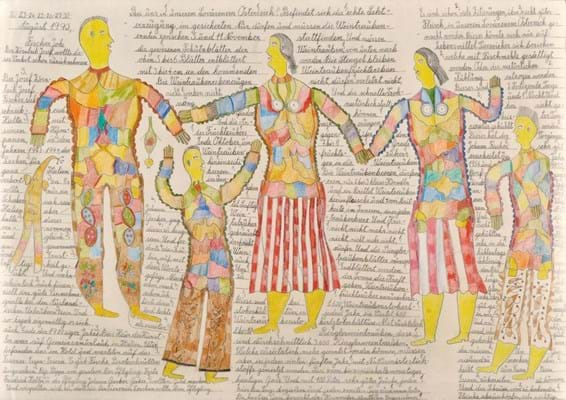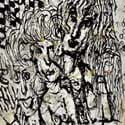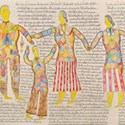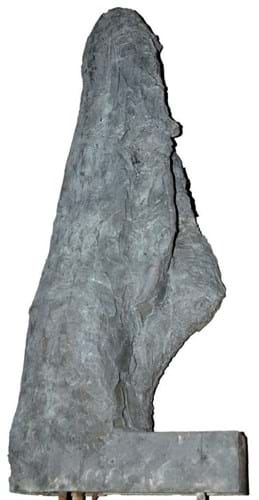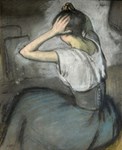Art Brut, or Outsider art, defined by French artist and founder Jean Dubuffet as “works produced by persons unscathed by artistic culture”, is still a market in its infancy.
But what was once an anti-establishment movement has now gone mainstream, driven by a niche field of moneyed collectors based mainly in Europe, North America and Australia.
A clutch of these buyers took part in the 200-plus lots of mostly Outsider art offered in Newcastle without reserve on October 18.
The collection, which broke several artist records, was that of Christian-Leopold Heppe, founder of Hildon mineral water, who started collecting in the 1970s.
Following Heppe’s death last year, Anderson & Garland auctioneer John Anderson said he had been “hungry” for the collection, and was offered the opportunity to sell it after “a bit of good luck and a lot of hard work”.
Last November’s sale of David Bowie’s art collection at Sotheby’s was a watershed moment for the field, especially for the sell-out section of works by the Gugging Group of artists from Vienna. These were patients who underwent psychiatric therapy at the Maria Gugging clinic, and were encouraged to express their creative sides on paper and canvas.
Like Bowie, Heppe was an admirer, and assembled a comprehensive catalogue of works by the group.
In all, the running total for the collection, with after-sales ongoing, was just over £500,000 – well over the pre-sale projection of £300,000.
Prices at the sale were erratic at times: some pieces predicted to sell well got away just in or below expectations or not at all, while others left guides far behind.
According to the auction house, there was confusion among some bidders who thought several unsold works had sold during the sale, and subsequently hastened to buy them after.
On the day, a number of works by Arnold Schmidt (b.1959) and Walter Navratil (1950-2003), the son of Gugging’s founder, psychiatrist Leo Navratil, went unsold.
A pair of heavy monochrome canvases by Herman Dirk van Dodeweerd (known as Armando) failed to get away with estimates of £10,000-15,000 each.
A record was established for Gugging artist Oswald Tschirtner (1920-2007), whose 13 drawings of elongated figures were pursued by several bidders.
The largest, at 7ft 6in (2.3m) high, sold for £7800 hammer, beating the previous high fetched at auction house Kinsky Kunst in Vienna for a premium-inclusive €9375 (around £7900) in November 2010.
Baker makes dough
A strong price emerged for Johann Fischer (1919-2008), a baker who became a resident at the Gugging clinic after receiving psychiatric treatment in 1957.
This was achieved for a 19 x 2ft 3in (49 x 70cm) coloured crayon drawing of figures against reams of dense handwritten text and dated to 1993.
It took £8800 against a £800- 1400 guide, one of the highest prices for a single drawing and in line with the £19,000 record set at the Bowie sale at Sotheby’s for a pair of drawings of his father and mother.
Strong demand was also evident for the increasingly popular Austrian Outsider August Walla (1936-2001), a schizophrenic who was raised as a girl by his mother to avoid being enlisted in the German army. The Bowie sale established a new high for the artist when his monumental Ewigkeitendegottt, Sein Engel, sold for £55,000.
This momentum continued in Newcastle where all six of his coloured crayon drawings found buyers in or over their guides, including a double-sided 12 x 8in (30 x 21cm) self-portrait of the artist as a Russian girl, which sold for £7800 against an attractive £1000-2000 guide.
Beyond the Gugging lots, dramatic bidding greeted Raven Food, a 17 x 11in (43 x 28cm) double-sided drawing by Louis Soutter (1871-1942).
Soutter, a cousin of Le Corbusier, was institutionalised at the age of 50 in Switzerland and painted mainly with his fingers. The 17 x 11in (43 x 28cm) pen and ink on paper was knocked down at £42,000 – over five times the top guide, but some way off the six-figure highs his larger, figural works have made at auction.
Leading Outsider artist Friedrich Schröder Sonnenstern (1892-1982) was represented in the sale by two paper drawings of the artist’s trademark monster figures. They sold a little under expectations of £10,000-15,000, at £10,000 and £7000 respectively.
Sale best-seller
Packing the sale’s biggest financial punch was a group of bronze sculptures by Per Kirkeby (b.1938), a versatile Danish artist unconnected with the Outsider movement. The eight bronzes sold at a combined £185,700 – a quarter of the sale total.
The top lot, Der Grosse Kopf mit Arm, of a large 6ft 6in (2m) high head cast in 1983 in an edition of six, sold at £52,000.


